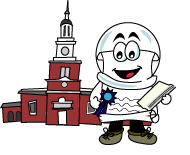| |

 
You have chosen Time Warp: EVENTS! Follow A. Bill back in time and explore significant events throughout the history of the U.S. House of Representatives!

 The First State of the Union Address The First State of the Union Address
 The annual message of the President, currently known as the State of the Union address, is mandated by the U.S. Constitution:
The annual message of the President, currently known as the State of the Union address, is mandated by the U.S. Constitution:
”The President shall from time-to-time give to the Congress information on the State of the Union, and recommend to their Consideration such measures as he shall judge necessary and expedient.” Article II, Section 3, Clause 1.
The first annual message was delivered by George Washington. Some historians believe President Washington’s 1789 inaugural address functioned as the first annual message; however, most historians consider Washington’s address of January 8, 1790, to be the first annual message.
Delivered to a joint session of Congress at New York City’s Federal Hall, Washington’s address of 1790 focused on managing the new union of states. Washington stressed the importance of national defense; the promotion of science and literature; and uniformity in currency, weights, and measures. He was so committed to the unity of the new nation, that he wrote “United States” on the dateline of the message, instead of “New York,” the nation’s capital at the time of the address.
Early annual messages outlined foreign affairs and Indian affairs. Later, as the Civil War approached, slavery and states’ rights were spoken of with increasing frequency. Specifics were avoided, but general issues that needed study were identified, and the details were left to Congress.
Eventually the annual message of the President became known as the State of the Union address and as a platform for the President’s goals and vision for the country.

 The First Foreign Dignitary Address The First Foreign Dignitary Address
 The Marquis
de Lafayette, hero of the American Revolution, visited all 24 states in the
Union during his triumphal return in 1824-25. Everywhere he went he was greeted
with parades and ceremonies. The Marquis
de Lafayette, hero of the American Revolution, visited all 24 states in the
Union during his triumphal return in 1824-25. Everywhere he went he was greeted
with parades and ceremonies.
This portrait of the Marquis de Lafayette (right), based on one made from life
and given by the artist to the House of Representatives on the occasion of Lafayette's
visit in 1824, hung in the Old Hall of the House until it was moved to the present
House Chamber in 1858.
In this Hall, on December 10, 1824, Lafayette became the first foreign dignitary
to address a joint meeting of the House and Senate. He concluded as follows:
"Sir, I have been allowed, forty years ago, before a Committee of a Congress of
thirteen states, to express the fond wishes of an American heart. On this day
I have the honor, and enjoy the delight, to congratulate the Representatives of
the Union, so vastly enlarged, on the realization of those wishes, even beyond
every human expectation, and upon the almost infinite prospects we can with certainty
anticipate."
Congressman John Quincy Adams delivered a eulogy to a joint session of Congress
in the Old Hall of the House when Lafayette died in 1834.
|
|


 The annual message of the President, currently known as the State of the Union address, is mandated by the U.S. Constitution:
The annual message of the President, currently known as the State of the Union address, is mandated by the U.S. Constitution:





 The Marquis
de Lafayette, hero of the American Revolution, visited all 24 states in the
Union during his triumphal return in 1824-25. Everywhere he went he was greeted
with parades and ceremonies.
The Marquis
de Lafayette, hero of the American Revolution, visited all 24 states in the
Union during his triumphal return in 1824-25. Everywhere he went he was greeted
with parades and ceremonies.